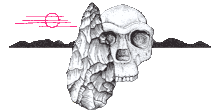Biomechanical Studies
How have our bodies changed and adapted to our tool-making in the course of human evolution? The configuration of our bones and muscles determines what motions and actions we can perform well and efficiently, and these have changed in human evolution as the human body has evolved into its modern form. The modern human hand, arm, and shoulder are product of at least 2.5 million years of evolutionary selection for tool behavior. To appreciate these changes, it is important to examine the actual biomechnical patterns involved in efficient stone tool-making.
A pilot study by Stone Age Institute affiliate and kinesiologist, Jesus Dapena, and Nicholas Toth examined the biomechanics of manufacturing Oldowan artifacts. Stone Age Institute graduate researcher, Leslie Harlacker, is currently conducting a comprehensive study comparing the biomechanical patterns of tool-making among human novices to those observed in experienced stone knappers, and also comparing the patterns of humans to tool-making apes, as part of her Ph.D. dissertation research.


